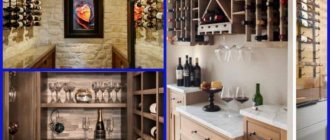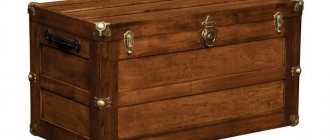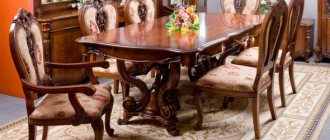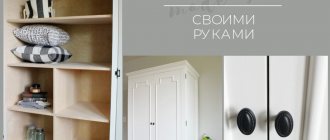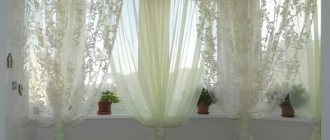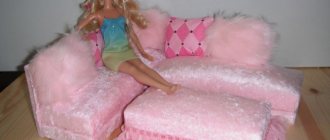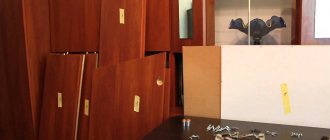To store wines in the cellar, you need a special rack, where each bottle will be assigned a separate cell. If the house does not have a cellar, but the stock of wines is substantial, and these are collectibles that need to be stored at a certain temperature and humidity, you will need a special wine cabinet for them. A ready-made wine cooler is more of a household appliance (refrigeration equipment with a compressor) than furniture, and it is very expensive. For ordinary wines, a shelf or a small cabinet where the bottles are arranged horizontally is sufficient. You can make this option yourself from scrap materials.
How to make a built-in cabinet under a countertop
Such cabinets are produced without external edging. They can be placed in any room without disturbing the internal harmony of the room. It will look great in the kitchen under the countertop, in the bar counter. It is better to make it strictly according to individual sizes, since the manufacturer can change the parameters of the products. Standard cabinets have transparent doors with anti-ultraviolet coating. They do not need additional covering.
The only disadvantage of countertop cabinets is their insufficient volume. When ordering a factory model, please note that the capacity is calculated without taking into account the shelves. In reality, the number of bottles that the structure can accommodate must be reduced by a third.
Any changes to the built-in furniture in the kitchen will help increase the comfort and efficiency of working in the room. Kitchen cabinets can easily be converted into wine cabinets, making the interior more convenient and adding appeal. You can also use the lower empty part of the island cabinet.
Read also: How to make a rocket engine from a shell casing
How to choose
The choice of wine cabinet depends on personal preferences, available space and financial capabilities. A standard ready-made cabinet has a full range of necessary functions and a simple design. More expensive models are equipped with additional options and are decorated more effectively. Elite devices are made to order for expensive and rare varieties and are equipped to ensure long-term perfect preservation of the drink.
The main task of a wine cabinet is to provide all storage requirements. To ensure that the purchased unit is distinguished by its functionality, reliability and long service life, we provide several recommendations for selection.
- Vibration is not allowed. Careless handling spoils the wine, promotes sedimentation, and disrupts the ripening process. Equipping with shock absorbers and shelves made of strong wood is a must in a cabinet with a compressor. The non-compressor model eliminates the risk of vibration.
- Stable temperature and humidity. The storage regime must not be violated; constant temperature and humidity indicators must be observed.
- The collection, which includes different types of wines, is placed in a cabinet with isolated zones.
- Protection from light is required. An open closet is only permissible in rooms without windows and bright lighting. In all other cases, doors made of wood or tinted glass are hermetically sealed. Lamps without heating are used.
- Ventilation is necessary. Carbon filters do a good job of cleaning the air and removing foreign odors.
Electric Wine Storage Cabinets: Pros and Cons
The main function of electric wine coolers is to maintain the optimal temperature for each bottle of wine placed in it. It should also prevent air from entering the container, which can cause oxidation. Expensive models have a humidity control function. This allows you to set optimal values that will prevent the cork from drying out.
Another advantage of storing wine in a special device is the presence of a filter for air purification. This will eliminate the appearance of foreign odors. Special compressors minimize vibrations, which prevents shaking and the appearance of sediment. The only negative side is the high price of even the simplest model.
How to make a wine cabinet with your own hands
You can make a wine storage cabinet yourself at home. This will require minimal carpentry skills and a set of tools. First of all, you need to decide on the location of its installation and the dimensions of the room. The listed parameters directly affect the dimensions of the planned product. For a small room, preference should be given to small narrow pieces of furniture.
When drawing up a project, you should think in advance about what materials will be used and decide on the principle of organizing the internal space. It is worth considering the fact that diagonal shelves are the most difficult to make, and not everyone will succeed the first time. For beginners, it is better to choose simpler designs. For example, consider a master class on making a wooden cabinet.
Required tools and materials
Before starting work, it is necessary to select and prepare raw materials. Wood for making furniture must be smooth, the presence of knots and mechanical damage on the surface is unacceptable. Any deformations reduce the service life of manufactured products. Also, for carrying out events you will need the following set of tools and materials:
Shabby chic
Using the decoupage technique, you can refine even those things that have already completely lost their aesthetic appearance. Nowadays, in this way, they add individuality not only to old products, but also to completely new pieces of furniture.
To decoupage an old small cabinet with your own hands, in which useful things for the home are stored, you can choose plant motifs and floral patterns. To carry out the work of restoring old, worn-out furniture, you will need the following materials and tools:
- napkins with large floral patterns;
- glue for decoupage - special or PVA;
- acrylic lacquer;
- wide brush;
- acrylic paints brown and white;
- paraffin candle.
Follow this tutorial for decoupaging a small cabinet with your own hands:
- If the cabinet you want to extend the life of is covered in paint, you will need to remove a layer of that old paint coating. It is enough to sand furniture that is not covered with paint, removing all the unevenness and roughness of the surface of the material.
- Paint the cabinet with brown paint in one coat, both inside and out.
- Once the paint has dried well, treat the surface of the piece of furniture with paraffin to create the natural scuff marks typical of shabby chic pieces.
- Prime the cabinet with one or two coats of white acrylic. It is necessary to make a translucent coating; it should not be dense.
- Using sandpaper, go over the areas that were treated with paraffin. During this type of work, the top layer of material will be removed, revealing dark paint, creating a scuffed effect on the furniture.
- Now you can start applying patterns to the surface of the furniture. To do this, take napkins with flowers, remove the top two layers of paper, leaving only the one on which the image is located. Having prepared the required number of motifs, attach them to the closet and think about how well they will look in the chosen place. Consider the ability of paper napkins to stretch when glued to a hard surface.
Place the napkin on the furniture, hold it with your hands and cover it with glue on top, pressing it tightly with a brush to release air bubbles. Such actions should be performed very quickly, since the napkin will immediately become wet and the picture may be damaged. When all the motifs are glued, leave them to dry for several hours
To speed up this process, you can use a hair dryer. Sometimes small wrinkles may be visible on dried napkins; these can be carefully smoothed out with fine sandpaper. The final stage of decoupage is varnishing the furniture.
This option for decoupaging a cabinet using napkins with your own hands is shown in the photo below:
Tackle the foundation
Drill overlapping holes to make sockets 32mm long by 14mm deep on two faces of each piece as indicated on the template.
1. Glue two blanks measuring 38x51x240 for the legs J. Each piece will make two legs.
2. Make two copies of the leg template. Using spray adhesive, attach them to the blanks by bending them along the fold line. Place a 6mm diameter drill bit into the drill chuck and form 32x14mm sockets in the locations indicated on the template (photo D ). Then use a sharp chisel to level the walls of the nests and trim the corners.
3. Cut out the legs along the contour lines using a band saw and sand, but do not separate them. Insert a cutter for roundings with a radius of 3 mm into the collet of the router installed in the table and process the workpieces on both sides, as indicated in the template and Fig. 1. Sand the workpieces smoothly.
4. Using a saw machine, using a crosscut (angle) stop with a wooden pad and an end stop-stop that ensures the parts are the same length, saw off two legs 114 mm long from each workpiece.
5. You are sawing the kings K. Using a groove disk, form 6x13 mm tenons at the ends of the frames, fitting tightly into the sockets of the legs (Fig. 1 and 1a). Before sawing tenons on parts, check the settings of the sawing machine on scraps of the same thickness. Having cut out the cheeks of the tenons, place each drawer on a narrow edge and reduce the width of the tenons to 32 mm.
6. Install a standard 3 mm thick blade into the saw machine. Make a couple of shallow cuts on the top side of each drawer (Fig. 1a). The cuts will serve as traps for excess glue when attaching the base to the body. Sand the sides smoothly.
7. Dry assemble the base by connecting the drawers K with the legs J , and make sure that the parts fit accurately. Then glue the base (photo E).
Glue legs J and drawers K together, aligning the pieces along the top side. Check the squareness of the base by measuring its diagonals.
Glue the J/K base to the bottom of the C/E/F body, lining up the side gaps. The legs J should be flush with the back of the cabinet.
8. Place the case on the floor with its bottom upside down. Apply glue to the upper edges of frame K between the cuts. Align the J/K with the body and secure with clamps (photo F ).
Wine rack for storing bottles in the home
A rack for wine bottles is one of the ways to give your apartment or house a more stylish look. There is far from one option today, it all depends on capabilities and imagination.
For example, the idea of building wine storage rooms from glass and polycarbonate is common. But storing wine on such a structure is far from ideal, so this kind of room is considered more like a cabinet or refrigerator.
Important!
A more logical solution for organizing shelving racks is under the kitchen floor. Such conditions make it possible to have high-quality drinks of a decent level even in the heat.
A significant collection of wines is placed on a rack to give the kitchen or dining room a special aura. A wooden cabinet made of shelved cells looks very impressive. This option is a godsend for professional collectors.
Bottles also adorn kitchen shelves as souvenirs. True, this is not particularly useful for the drink itself; it can deteriorate in just three days, so experts do not approve of such placement.
In general, there is no general advice on what such a rack looks like. This design, like any house, is a subject of personal preference.
Table with wine rack
At home, wine can be stored in a variety of places. The best option is a special refrigerator. But, if it is not possible to install such equipment, you can make a beautiful table for the living room with special holes for bottles.
You can make a simple piece of furniture according to a standard plan or give it originality by using your imagination. The round table with side compartments for wine looks interesting. Circular strips are nailed to the bottom of the tabletop and holes are made in them to suit the size of the bottles. The legs can be made straight or a fancy design can be created.
Design options
A wine cabinet is often a simple and practical design. However, there are interesting design options that can be used to create a distinct style in a particular space. At home, such equipment is often mounted directly into the kitchen unit, which may have a glass or opaque door. Another interesting placement option is to create special cells with cooling directly into a bar set or cabinet. Such designs are very practical and allow you to store a large number of drinks in one place and in a small space.
There are also classic variations of installing cabinets for wine bottles as a separate piece of furniture. There may be a refrigerator nearby. The option of placing a corner wine cabinet in such a way as to save space is gaining popularity.
The design of cabinets can be exclusive, but such furniture is more expensive than standard models. This can be an elegant single door tabletop option or a storage unit with two doors, a product with glass holders and a bar. A teak cabinet with darkened glass doors looks elegant.
Built into the kitchen unit
Built into the bar set
With glass holders
Manufacturing materials
Wood is considered the best material for making wine cabinets (except for conifers with a characteristic resinous odor). A wooden cabinet is a traditional storage unit that has long earned its impeccable reputation among collectors .
Wood allows wine to breathe and maintains the desired temperature and humidity. Wood species that are distinguished by their durability and excellent aesthetic characteristics are especially valued. Wood lends itself perfectly to self-repair and restoration.
The following breeds combine all these requirements:
- Red tree;
- cherry;
- oak;
- Karelian birch;
- acacia;
- nut;
- ash;
- maple.
Metal and plastic are used to produce high-tech wine refrigerators. Such equipment regulates and maintains the required parameters regardless of the temperature and humidity of the environment. Small models fit perfectly into home kitchens, and large refrigerators are installed in restaurants and cafes.
Clay is used to make drainage pipes, in which wine bottles remarkably preserve the properties of the drink. Tinted glass is often used for wine cabinet doors. Such glass prevents ultraviolet radiation from entering the cabinet, preventing oxidation of wine and sedimentation. In addition, tinted doors look impressive and decorate the wine cabinet.
Another original idea
And so, now you have as many as 13 ideas for equipping a wine storage. If you have your own original ideas, don't forget to share them in the comments!
You'll also like:
Wine cabinet for living room made of laminated HDF
A cabinet made of wood material will be an excellent addition to any living room interior. The decorative effect of HDF sheets lies in the special technology of their production. Several layers of varnish of different colors are applied to them. Then they use special equipment to achieve a pattern on the surface that imitates the structure of various types of wood. This approach makes the material for the wine cabinet noble and refined.
A piece of furniture in the living room can be of any size and configuration. More often this is a floor option. Inside the design there is space for several wine bottles, a compartment for glasses and cups, a drawer for bottle openers and other accessories. This compartment is covered by two doors with translucent decorative inserts. The lower open tier can be used simply as a shelf.
Instructions for creating a cabinet
To begin with, you should make a sketch of the furniture on paper, think over the location of the shelves, take all measurements, calculate the dimensions of the parts and buy components and fasteners. To work you will need:
- level and square;
- pencil, tape measure;
- screwdriver;
- drill;
- saw and jigsaw;
- grinding machine or sandpaper;
- planed boards from 20 mm thick;
- bars 30*30 cm;
- sheet plywood;
- metal corners;
- paint, antiseptic and varnish;
- fasteners (screws, nails).
The procedure for making a cabinet
Bars, plywood and boards are cut according to measurements. The side parts, partitions, doors, shelves, top and bottom of the cabinet are made from boards, the back wall is made from plywood, and frame elements are made from bars. All elements are polished and treated with an antiseptic.
First of all, a frame is assembled from the timber using self-tapping screws, and the perpendicular joints are fixed with iron corners. Afterwards the frame is sheathed with boards and the back with plywood.
Important! The size of the cabinet cells must correspond to the dimensions of the bottles.
Assembling a wine cabinet
You can simply cut out recesses for containers in the shelves if you have the right tool. At the end of the work, the doors and fittings are attached, the entire product is painted and varnished. Such a cabinet will cost a small amount, but will fit perfectly into the surrounding space and become a reliable place to store a noble drink.
Design Features
A modern wine cabinet is the ideal storage for a noble drink. Cabinets provide the required temperature and ventilation, maintain humidity, and protect from direct light. Temperature cabinets are designed for short-term storage, while climatic structures are designed for long-term storage and create conditions similar to a wine cellar.
In addition to the aesthetic appearance, the cabinets are equipped with a climate control system. The operating principle of this system is similar to the operating principle of a refrigerator. The compressor reduces the temperature, the ventilation system ensures uniform distribution of cooled air. Carbon filters clean the air of fine dust. For illumination, lamps that do not heat the air are used.
The compressor creates a slight vibration, so the system provides structural protection - mechanical impact on the cabinet is unacceptable for storing wine. The compressor is secured so that it does not come into contact with the cabinet walls. Compressor trays are made of dense wood. Special rubber shock absorbers installed in cabinets dampen vibration.
The most modern models are created according to the Peltier principle. They use thermoelectric cooling, where thermal energy is pumped out of the chamber. The moisture partially settles on the walls, thereby achieving the desired percentage of humidity. Excess liquid is removed outside by a special drainage system. They control the equipment using the built-in panel or remote control.
Cooling technologies
Depending on the model, a wine cabinet may offer several different drink cooling technologies:
Absorption cooling
Absorption is the quietest technology that does not make any noise during operation. It is based on evaporation and heat absorption through chemical reactions. Thanks to its silent operation, the absorption cabinet can be installed in any room. But this technology is not without its drawbacks - high price, high electricity consumption and the presence of harmful substances in the system.
Compressor cooling
Compressor – cools the contents by compressing and expanding gas. When it contracts, it evaporates heat, and when it expands, it absorbs it. The main advantage of the compressor is its efficiency. It does not consume a lot of electricity, but maintains the set temperature well. It is also good that the compressor cabinet is quite narrow, which allows it to fit into any space.
Thermoelectric cooling
Thermoelectric - carries out cooling using a special plate, which, when voltage is applied, cools one side and heats the other. Thermoelectric wine coolers may produce noise, the volume of which depends on the quality of the devices themselves. An expensive model will be almost silent, while a cheap model will cause noise discomfort.
This technology is good because it is low cost and does not emit vibrations or vibrations during operation.
Why do you need a home bar for alcohol?
The design of this product can be both complex and simple. For example, sometimes the owner of the house cannot choose a suitable option to match the finished interior. Perhaps there are too many departments inside or, conversely, the compartments allow you to store something that is not at all what you need. Therefore, there is a desire to make a bar yourself. Let's decide why it is still needed:
- This design attracts attention wherever it is located. Sometimes not everyone can guess what's inside. Accordingly, such a specimen in the room plays an aesthetic role.
- The device is designed for storing expensive alcoholic drinks or refreshing invigorating cocktails. They are relevant at business meetings and holidays when guests gather in the house. It is irrational to store drinks in the refrigerator.
- Even homemade wine will not spoil if stored in a dark place. As a result, the taste of the drink from the correct content will only be better, more interesting and more refined.
Of course, a minibar in the house will be in great demand if at least one of the listed factors is present. It is important that the design has several shelves and compartments for placing bottles.
Spectacular minibar for strong drinks made of natural wood with a varnished surface PHOTO: rmnt.ru
A minibar can be made from an antique suitcase or a massive chest of drawers PHOTO: kreuzwortraetsel.me
Wall racks
Not everyone is lucky enough to have extra space for a built-in wine rack. However, everyone will definitely have a free wall.
So why not use the empty space for a minibar? This project from Shanty 2 Chic was brought to life using a few pieces of wood and large hex screws. Light wear and marked title stickers give the shelf an elegant look, turning it into an antique piece.
An unusual option is offered by the designers of Hart's Desire Photography. This wooden shelf allows you to store your drink at an angle of 45 degrees. It looks a little dangerous, but in fact, the design is very reliable!
If you prefer versatility and multifunctionality in everything, then the project from The Kurtz Corner is what you need! By attaching special threaded trays to a regular hanging box, you will accomplish two tasks. This will be a shelf for storing both wine and glasses.
Our next idea comes from Erin's Lane/Etsy. Everything is extremely simple: all you need is a massive wooden board and a few cast iron bolts from the railway. Combine all this and you have a rustic wine rack in your home! A quick but very stylish DIY project.
Types of shelves and their features
You can organize your wine storage system in different ways. Cabinets, racks, racks, and shelves are used to place bottles. Let's look at the last option in more detail. It is worth considering the fact that not all types of furniture products are suitable for placing alcohol, only wall-mounted and corner models. Suspended structures attached to the ceiling should not even be considered.
There is a wide variety of shelves. According to the design, the following types are distinguished: consoles, with side walls, with a rear partition, single-tier, multi-tier, combined. By mutual arrangement - single and group. By position in space - vertical, horizontal, diagonal, inclined, and each of the listed types has its own advantages and disadvantages.
Vertical
The variety of shelves located vertically is very large. They allow you to store bottles both vertically and horizontally, but the first method is used very rarely. Depending on the available space, you can choose different models. In one case, the container is laid perpendicular to the wall, with the neck or bottom facing outward, while others make it possible to place wine drinks parallel to the partition.
Narrow shelves can be attached not only to the wall, but also to cabinet furniture. The simplest product, located vertically, is a wooden beam or board with round holes drilled through it of a certain diameter. The necks of the bottles are inserted horizontally into these grooves from two different sides. The result is a kind of tree with branches.
Start with the body
1. From 19 mm plywood lined with cherry veneer, cut out the side walls A , top panel and shelf B , and bottom C according to the dimensions specified in the “List of Materials”.
2. On the inside of the side walls A , cut grooves and folds 19 mm wide and 10 mm deep ( Fig. 1) for inserting the top panel and shelf B. , cut a 6x10 mm fold along the back edge to insert the plywood back wall I.
D from a 19 mm thick cherry board . Mill a 6mm wide chamfer on the front side of the posts along both edges, not extending 50mm to the ends. How to do this carefully, avoiding chipping, is described in the “Advice of the Master” on the next page.
Master's advice
When milling partial chamfers, avoid burns
Surely you have already encountered chips and burns when milling incomplete chamfers. Chipping usually occurs when you try to rout an entire bevel in one pass.
Expert opinion Ekaterina Anatolyevna Smirnova has been engaged in interior design for 7 years, a professional architect
Burns occur when the rotating cutter becomes stuck in one place, so it is necessary to quickly move the workpiece away from the cutter at the end of the pass. There is an easy way to avoid these problems.
Having placed the workpiece on the edge and resting its rear end against the stopper, move it towards the cutter with a rotating motion, as shown in (left photo below). Without worrying about chipping or burning at the end point, mill about two-thirds of the bevel length.
Then turn the workpiece 180° with its ends and turn it face down so that the partially chamfered face is facing the longitudinal fence (right photo below). Mill again, finishing the pass on the already finished area.
4. Glue the posts D to the side walls A (Fig. 1), aligning the ends and outer sides. Once the glue has dried, sand the parts using 220 grit sandpaper.
5. In the top panel B , make a pair of mounting holes, countersunk from the bottom, and two slotted holes (slots) 4x10 mm for attaching cover G (Fig. 2). To form each slot, drill a series of overlapping holes.
Insert a spacer between the D posts and press the bottom with the C/E/F pads against the body, aligning it in the middle.
Using a 4mm pointed drill bit, mark the centers of the holes in cover G through the slots and mounting holes of top panel B.
Wardrobe with doors to the nursery
This cute cabinet can store anything, even a TV.
Suitable not only for children's rooms, but also for any other room. Making a cabinet with your own hands is not difficult. Simply attach the sides to the base and shelf using the dimensions shown in the photo. Keep the back edges flush. Attach the top, keeping the back edges flush.
The front will stick out about 1/2 inch. Use nails and glue to secure the back as shown in the diagram.
Next add the top trim, use fasteners to attach the sides to the end edges of the top trim.
Check that the door has a gap of approximately 3 mm. Attach the strips to the rear door panels using staples or nails as shown in the diagram. Make sure the edges are flush. Glue and secure in place as directed in step 2. Lay the door on a flat surface to dry, placing heavy objects on top. The cabinet is almost ready, all that remains is to secure the doors and install the shelves.
Photo source: www.ana-white.com/2010/01/plans-cubby-media-wall-hutch-with-doors.html
Children's wardrobe on wheels
This convenient mobile block design looks great and can be designed to fit your space. Here's how to make your own children's closet, as well as what tools and materials you'll need. Once you have chosen the size of the block you are going to make, cut the plywood to the required dimensions. For the frame, cut 600mm x 2250mm wallpaper in half to make four 300mm x 2250mm pieces. Then cut two of them at 1330mm for the sides and two at 1200mm for the top and bottom. For the shelf and dividers, cut 2400mm x 1200mm x 17mm ply into 300mm pieces along the 2400mm length to make eight pieces. Then make the frame. Make sure all corners are square and drill holes to connect the pieces. Use 50mm screws. Secure the first shelf and dividers. Starting from the bottom, install one of the 1200 mm shelves into the frame. The space should run evenly along the bottom of the frame.
Photo source: www.bunnings.com.au/diy-advice/home-improvement/shelving-and-storage/diy-cube-storage-unit
Bedside cabinet for children's room
A wooden bedside table for a nursery is the perfect way to keep your children's bedrooms tidy.
The children's locker not only looks great, but also has functional shelves and a convenient storage drawer that will help keep books and toys safe and sound. Look at the step-by-step photos and you will be surprised how easy it is to do.
Photo source: www.bunnings.com.au/diy-advice/home-improvement/shelving-and-storage/diy-kids-wooden-storage-bench
How to assemble a cabinet for a nursery
Assembly from ready-made panels is the easiest and most affordable way to make a children's locker with your own hands. This compact cabinet is the quintessential building block in a flexible modular storage system. You can add drawers, a shelf or a door to customize your closet. Convenient and economical in the sense that you can buy only as many shields as needed to assemble one unit.
Master class on how to assemble this simple cabinet, see step-by-step photos below.
Photo source: www.diy.com/ideas-advice/how-to-assemble-flatpack-cabinets-shelves/CC_npci_100108.art#page-top
Floor bookshelf for children
This children's wooden bookshelf allows you to display your child's favorite books or toys.
The shelf is really easy to make and you can paint it to suit the room's design and your child's tastes. Below, see the master class with step-by-step photos.
Photo source: www.bunnings.com.au/diy-advice/home-improvement/shelving-and-storage/how-to-make-a-diy-kids-wooden-bookshelf
Material
Wooden wine racks have proven themselves to be the most practical and durable - they do not fade or deform, and special coatings protect them from dirt. In addition, the tree does not overheat when exposed to direct sunlight.
Many manufacturers include plastic wine racks in their product range - they are cheaper than wooden ones, but tend to sag over time and stretch out when fully loaded.
Glass models are rarely found on sale and are not in great demand, since the likelihood of damaging them during cooking in the kitchen is quite high. When choosing such a model, you should give preference to tinted safety glass. The cost of the shelf may turn out to be unexpectedly high.
Holder made of hooks or metal plates
This design is suitable for a country style kitchen. Metal hooks are inserted into a large solid board. The board will be mounted vertically on the wall.
The hooks are fixed on both sides, at equal intervals.
Additional Information. To create a special authentic spirit, you can use cast iron bolts as hooks, like on a railway.
These bottle holders are great space savers.
Posting rules
There are two types of wine cabinets for the home: free-standing and built-in. A separate closet is installed so that it does not interfere with other pieces of furniture. The cooling radiator is placed on the rear wall or in the side of the structure. Built-in devices are compactly placed in furniture sets. Wall racks and shelves are the easiest and most functional option.
The ideal place to install a wine cabinet is the cellar, so it is easier for owners of private houses to decide the issue of placing a wine cabinet. In addition to the cellar, the underground and attic are excellent for wine storage. The space under the stairs, dark storage rooms - the choice of homeowners is very wide and allows you to show not only practicality, but also imagination. In the spacious cottage it is possible to allocate a separate room for storing elite varieties of collection wines.
Important! Using the refrigerated wine cabinet for purposes other than its intended purpose is unacceptable. You cannot store food together with wine - foreign odors and mold will appear.
However, lovers of good wine will be able to place the necessary equipment in the apartment. Most often, a wine cabinet is installed in the dining room or kitchen. A built-in wardrobe or wall rack is an excellent solution for an apartment. The design can be developed for any empty corner, free wall, or built into a countertop. You can also buy a modern small wine refrigerator and place it in any convenient place.
Where to install wine racks
For owners of private houses, it is best to build a wine cellar. If this is not possible, then you can equip an attic for storing wine. In most residential buildings there are no windows under the roof; it is always dark here. The main thing is to ensure the desired level of air temperature in the range of 10 - 15 degrees; if this cannot be done, you will have to consider other options.
Inside your home, you can install a wine rack or shelves almost anywhere. For owners of two-story buildings, you can opt for the space under the stairs. This will save usable space. The kitchen is not suitable for keeping the drink for a long time. The temperature here is constantly changing, there are many foreign odors that an alcoholic drink can absorb through a wooden cork.
Add glass holders
1. Cut out the middle and outer holders R, S from the cherry board. Using a standard saw blade, make folds 38 mm wide and 12 mm deep in two passes (Fig. 2). Then file a 3 mm wide chamfer at an angle of 45° on the longitudinal edges of the holders. (Formation of folds and chamfering is shown in the photo on page 20.)
2. Make chamfers 3 mm wide along the front ends of the holders R, S using a file (Fig. 2).
3. Drill mounting holes in the R, S holders and countersink them from the bottom. Make the holes in the outer holders S at an angle of 8° (Fig. 2a). Sand the holders.
Pressing the middle and outer holders R, S with clamps and inserting spacers 27 mm wide, drill guide holes in shelf B and screw in the screws.
4. To install the R, S holders in place, turn the body over and place it on blocks made of blocks to make it easier to work with the clamps (photo G). From a scrap of 19mm board, cut a 27x305mm strip and saw it crosswise into 45mm lengths to use as spacers. Place the holders on the underside of the shelf B flush with its rear edge and install 27 mm wide spacers between them. Secure the holders. Drill guide holes in the shelf through the mounting holes of the holders and screw in the screws. To simplify further finishing, remove the screws and holders, marking their positions, and set them aside.
Comparison of models
In order to compare the presented products, we suggest taking a look at the table below with their characteristics.
| Model | Number of compartments | Weight, kg) | Temperature range (°C) | Bottle capacity (pcs) | Price, rub) |
| Cavanova CV-004 | 1 | 9,7 | from + 7 to + 18 | 4 | from 13800 to 14200 |
| Dunavox DX-16.46K | 1 | 23 | from 4 to 18 | 12 | from 15900 to 16700 |
| Ecotronic WCM-16TE | 1 | 16 | from 10 to 18 | 16 | from 20000 to 22000 |
| Vestfrost VFWC 350 Z2 | 2 | 82,8 | from +5 to +18 | 102 | from 69990 to 79900 |
| Liebherr WKB 1812 | 2 | 45 | from 5 to 20 | 66 | from 65999 to 70391 |
